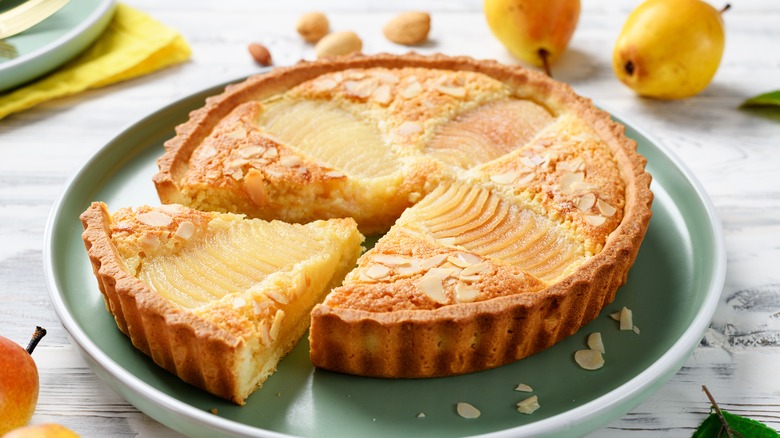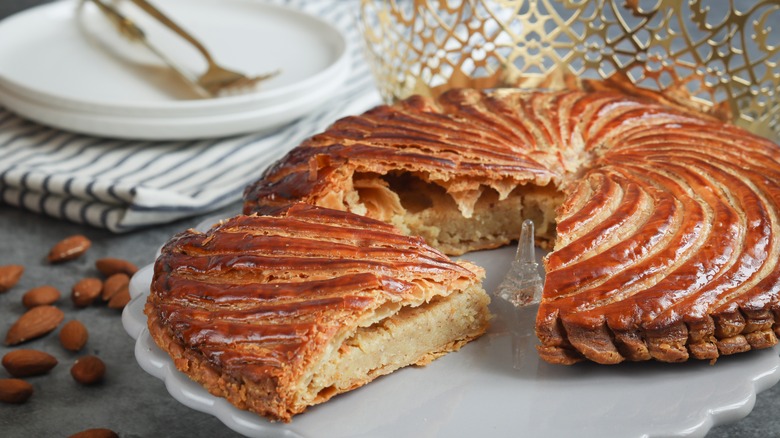What's The Main Difference Between Frangipane And Marzipan?
When you think of foods that get turned into multifaceted baking components, almonds may not be top of mind. You might think of molasses or ingredients like peanut butter, apples, or even cream cheese, but almonds aren't usually an automatic go-to in America. Such is not the case in other countries, though — particularly France, Italy, and Germany, where almonds rule the day as a baking component. You've probably heard of some popular almond-derived baking products, too, like frangipane and marzipan.
But what are frangipane and marzipan? Aren't they just different names for the same thing? While you might be tempted to think so from the similar-sounding names, not only are they not the same thing, but they're not even the same type of product. Frangipane is a rich, cream-based filling, while marzipan is a thick paste mostly used for decorative purposes. The main thing they have in common is the almonds required to make each one, but beyond that, they're wildly different — especially in consistency — meaning you'll find them used differently, too.
Marzipan is a moldable paste perfect for decorating
The key with marzipan is all about the texture. People are divided on the strong almond taste — some love it, some hate it — but what virtually everyone can agree on is it's easy to mold into various designs, with enough firmness to hold its shape. Ultimately, this allows bakers to create intricate, gorgeous desserts that are as much art pieces as they are confections. Nowadays, fondant is commonly used for a similar purpose — it takes color much better than marzipan — but there's no doubt that marzipan has a far deeper, richer flavor, and people typically dislike fondant even more than marzipan. In addition to being used as decoration, you'll often find marzipan molded into those gorgeous little fruits and other small designs to eat as is.
One legend of marzipan's origin dates to 15th century Germany. Supposedly, a shortage of flour led to the need for a replacement for bread, and bakers devised a mixture of ground almonds in a concoction of eggs and sugar. But that's not the only story; there are also claims from Persia, Hungary, Italy, Spain, and even as far away as China. Modern marzipan is slightly different, as it typically involves honey and almond extract (making the original more like almond paste). Whether or not any of these origin stories are actually true is another matter — a lot of food origin stories are totally apocryphal, like that one about potato chips you might've heard before.
Frangipane is a creamy filling with a milder flavor
While marzipan is similar to but distinct from almond paste, the same isn't true of frangipane and almond cream — they're one and the same. It involves ground almonds, just like marzipan, but that's where the similarities end. Sugar, eggs, vanilla, butter, and flour are added to the mixture, which is creamed until it possesses its trademark soft, custard-like consistency. Like most creams, it's typically used as a filling in baked goods. While the taste of marzipan can be divisive, frangipane doesn't suffer nearly as much from negative feedback, owing to its sweetness and generally more balanced flavor.
The commonly-repeated origins of frangipane are, much like marzipan, probably apocryphal: Popular legend claims it was created by French chefs in the early 17th century, inspired by the popular almond-scented perfume a nobleman named Muzio Frangipani introduced to the royal court. Regardless of where the two originally came from, though, both frangipane and marzipan have important purposes in baking and cake decorating. Just don't confuse the two, because you can't swap them for each other — their textures will make sure of that.


